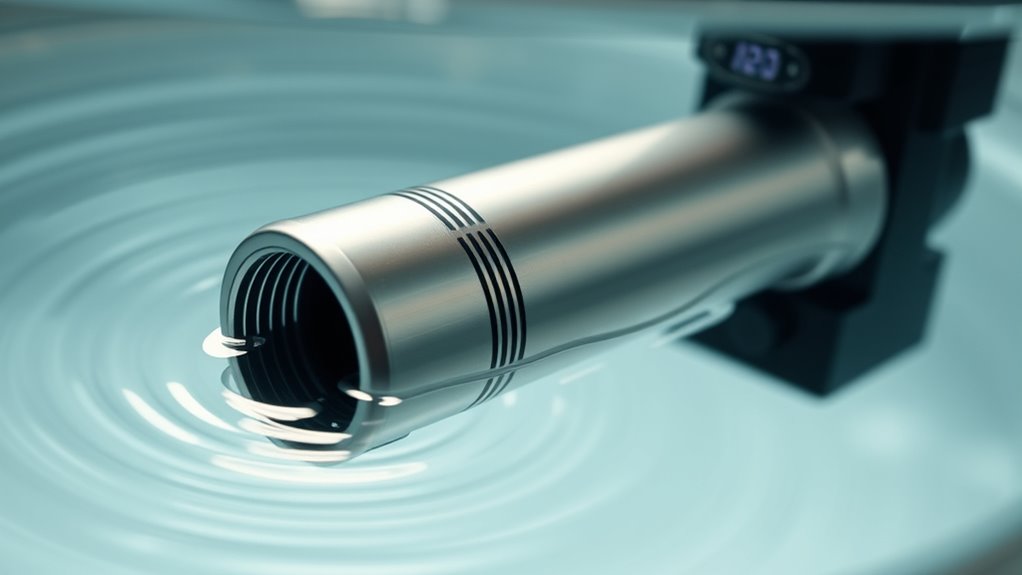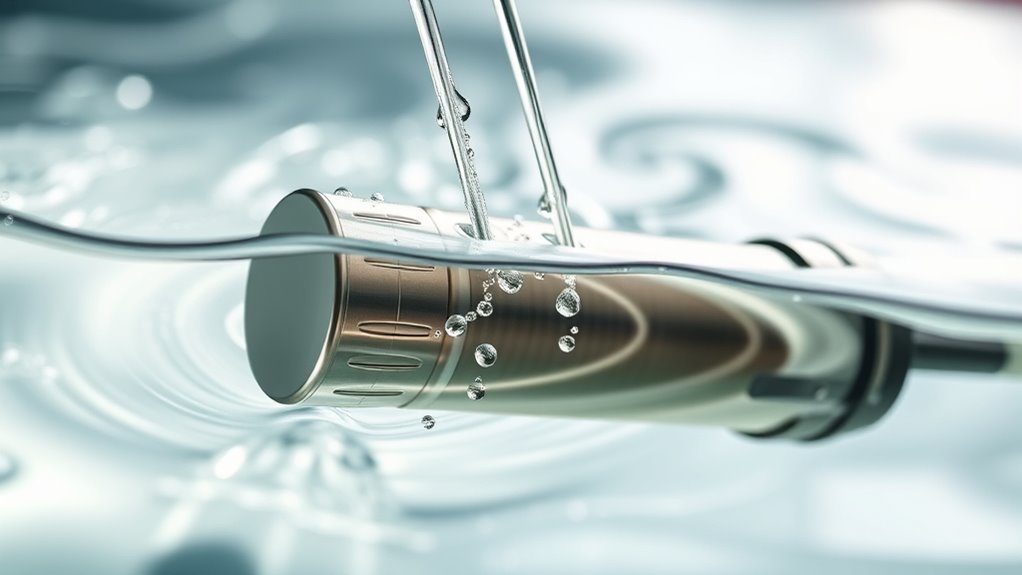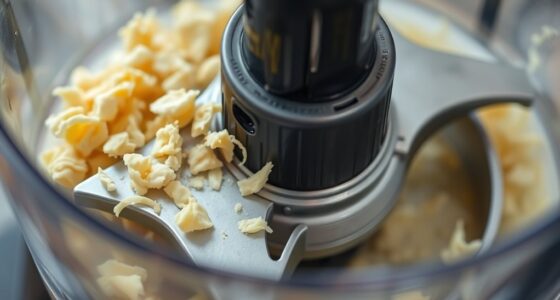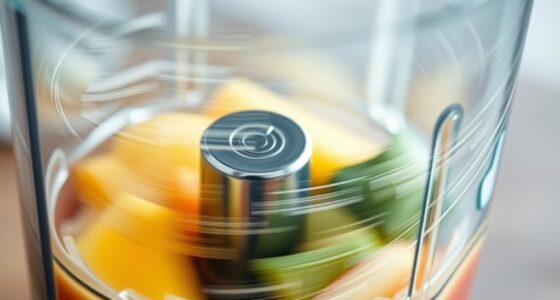In sous vide circulators, water flow physics guarantee even cooking by maintaining steady movement that prevents hot or cold spots. The pump pushes water continuously, creating a gentle, consistent flow that promotes uniform heat transfer. Sensors monitor water temperature and adjust the heating elements to keep it precise and stable. This dynamic interaction of flow and temperature control results in perfectly cooked food, and exploring these principles further will reveal even more about how they work together seamlessly.
Key Takeaways
- Pumps create steady, gentle water flow to ensure uniform heat transfer throughout the cooking bath.
- Sensors monitor water temperature continuously, prompting dynamic adjustments for precise heat stability.
- Consistent water circulation prevents hot or cold spots, eliminating temperature gradients for even cooking.
- The physics of water movement promotes efficient heat distribution, ensuring uniform temperature penetration into food.
- Effective circulation and control systems enable slow, even cooking while maintaining moisture, texture, and flavor.

Water circulation is central to the functioning of a sous vide circulator. The circulator’s pump pushes water around the cooking vessel, ensuring even heat distribution throughout the entire bath. Without proper circulation, hot and cold spots could develop, leading to uneven cooking. The movement of water eliminates these inconsistencies, allowing your food to cook uniformly, no matter the thickness or type. This constant flow also prevents temperature gradients from forming, which can compromise the final result. When water moves steadily around the food, heat penetrates evenly, making your dishes tender and perfectly cooked. Additionally, the type of pump used can influence the water flow rate, which affects how quickly and evenly heat is distributed throughout the bath. Temperature stability is another critical component. Sous vide circulators are equipped with advanced sensors and thermostats that constantly monitor the water’s temperature. Once you set your desired temperature, the device works tirelessly to maintain it within a very narrow margin of error—often just a fraction of a degree. This precision guarantees your food reaches the exact level of doneness without overcooking or undercooking. The combination of steady water circulation and tight temperature control creates an environment similar to a gentle, evenly heated bath, which is ideal for delicate proteins, vegetables, or desserts.
The physics behind this process is straightforward yet sophisticated. The circulator’s pump creates a gentle but consistent water flow, moving heat evenly throughout the bath. Meanwhile, the temperature sensors detect any fluctuations, prompting the device to adjust its heating element accordingly. This dynamic system prevents temperature drift, a common problem in traditional cooking methods. The result is a stable environment where your food can cook slowly and evenly, preserving moisture, texture, and flavor.
In essence, the effectiveness of a sous vide circulator hinges on its ability to combine water circulation with temperature stability. By maintaining a continuous, uniform flow of water at a precise temperature, it replicates a controlled cooking environment that’s hard to achieve with conventional methods. This combination allows you to cook food perfectly, every single time, with minimal effort and maximum consistency. Understanding these principles can help you better appreciate the technology behind sous vide cooking and why it’s become a favorite among professional chefs and home cooks alike.
Frequently Asked Questions
How Does Water Flow Affect Sous Vide Cooking Time?
Water flow directly impacts sous vide cooking time by affecting heat transfer efficiency. When you increase the flow rate, water turbulence improves, ensuring even heat distribution around your food. This prevents hot spots and speeds up cooking. Conversely, a sluggish flow reduces turbulence, causing uneven heating and prolonging cook times. So, maintaining a steady, high flow rate helps you achieve precise, consistent results efficiently.
Can Circulator Design Influence Temperature Stability?
Did you know that poor circulator design can cause temperature fluctuations of up to 2°C? Your circulator’s design directly influences temperature regulation by optimizing flow dynamics. A well-designed circulator ensures even water movement, reducing hot spots and maintaining precise temperatures. This stability is vital for consistent results in sous vide cooking. So, investing in a circulator with superior design enhances your cooking accuracy and overall success in preparing perfect dishes.
What Are the Common Causes of Uneven Water Circulation?
You might notice uneven water circulation caused by flow turbulence or issues with the pump mechanism. Flow turbulence occurs when water moves chaotically, creating hotspots or cold spots. A malfunctioning pump mechanism can reduce flow rate or cause inconsistent water movement. To fix this, guarantee your circulator’s pump is working correctly, and position the device to minimize turbulence, promoting even water flow for precise cooking results.
How Does Water Viscosity Impact Circulation Efficiency?
Think of water viscosity as its personal attitude—thick and resistant or smooth and enthusiastic to flow. Higher viscosity effects increase flow resistance, making it harder for the circulator to move water efficiently. This sluggishness hampers heat distribution, causing uneven cooking. So, when water’s thick with viscosity, your circulator struggles, and the water becomes a stubborn river, resisting the current and compromising perfect circulation.
Are There Differences in Flow Physics Between Brands?
You might notice differences in flow physics between brands, mainly due to variations in pump efficiency and design. Some circulators generate more consistent flow, reducing flow turbulence, which leads to better heat distribution. Others may struggle with efficiency, causing uneven water movement. When comparing brands, check how their pumps perform under load, as higher pump efficiency typically results in smoother, more controlled flow with less turbulence, improving your cooking results.
Conclusion
Just like Da Vinci studied the flow of water to perfect his art, understanding the physics behind sous vide circulators helps you master your culinary creations. With precise water movement, you uncover consistent, restaurant-quality results every time. So, next time you set your circulator, remember you’re orchestrating a delicate dance of molecules—turning simple ingredients into a masterpiece. Embrace the science, and let your kitchen become your own Renaissance studio.









